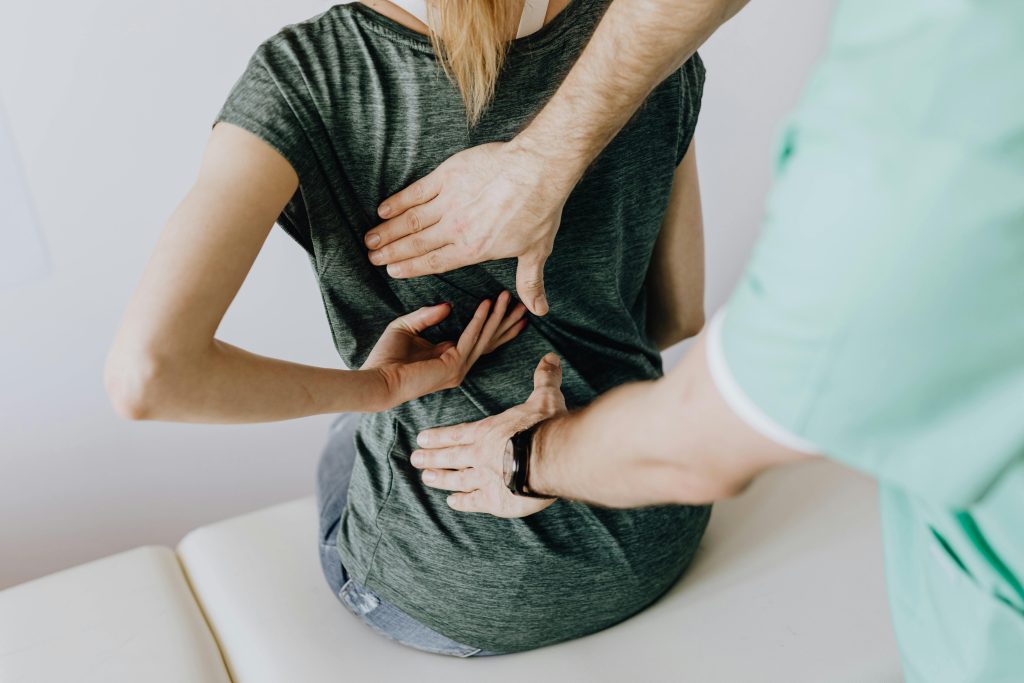
When you ask yourself, “Why does my back hurt when I workout my abs?” Consider the crucial connection between your core muscles and your lower back health. Engaging in core exercises like planks and sit-ups demands proper form to avoid strain on the lower back. If you’ve been experiencing pain, incorrect technique during these ab workouts may have contributed to your discomfort.
However, your pain may stem from a variety of other factors, which I will explore. It’s important to acknowledge that each individual’s situation can vary, and understanding the full spectrum of potential causes is key to addressing your lower back pain effectively.
Why Does My Back Hurt When I Workout My Abs?

The leading cause of lower back pain during ab workouts is poor form. For example, if you’re doing sit-ups or crunches and lifting your upper body off the ground using your neck or upper back muscles instead of your abdominal muscles, it can lead to back pain.
You Are Using Improper Form During Ab Workouts
Using improper form, especially during exercises like sit-ups or planks, can place undue stress on your lower back. Ensuring proper pelvis alignment and engaging your core muscles can prevent back strain.
Some common improper forms during ab exercises include:
- Ignoring Pelvic Position: Not maintaining a stable pelvic position during exercises like planks or leg lifts can lead to lower back strain.
- Failing to Control the Range of Motion: Extending the legs or torso too far, especially in movements like flutter kicks or Russian twists, which can put extra pressure on the back,.
- Lack of Sequential Movement in Sit-Ups or Crunches: Failing to curl up sequentially from the upper back to the lower back leads to jerky movements that strain the back.
- Inconsistent Exercise Pace: Performing some parts of an exercise too fast and others too slowly can lead to imbalanced muscle engagement and increased strain on the lower back.
- Flattening the Lower Back Against the Floor: Especially in exercises like leg raises or dead bugs, flattening the lower back too much can lead to spinal compression.
- Neglecting Lateral and Rotational Movements: Focusing only on forward and backward abdominal exercises, neglecting the obliques and deeper core muscles that support the spine from all sides.
- Skipping warm-up and cool-down: Not preparing the muscles for intense activity or allowing them to relax post-workout can increase the risk of muscle strain and back pain.
- Inconsistent Spine Alignment Throughout Movements: Not maintaining a consistent spinal alignment, especially during dynamic movements, can lead to an uneven distribution of pressure and increase the risk of injury.
- Overusing Weighted Equipment: Adding too much weight or resistance in ab exercises, like using heavy medicine balls or weights in crunches, can overstress the back muscles.
- Ignoring Muscle Fatigue Signs: Continuing to exercise even when core muscles are tired leads to other muscles, including those in the back, compensating and potentially causing pain or injury. An ideal ab workout should last 10–30 minutes, emphasising quality over quantity. Aim for 10–20 reps, like any other muscle group.
Your Hip Flexors and Quads Are Overcompensating
If your hip flexors and quads are stronger than your abs, they might take over during ab workouts, leading to lower back pain. Focusing on exercises that isolate the abdominal muscles can help.
You’re Progressing Too Quickly in Ab Exercises
It’s important to not rush into advanced ab workouts without first establishing a solid foundation. Doing so can result in lower back pain.
It’s crucial to gradually build up endurance before increasing the difficulty of your ab exercises. Treat your abdominal muscles like any other muscle group and exercise them in the same way.
Your Core Muscles Might Be Weak
Weak core muscles can’t effectively support the spine during ab workouts, causing the lower back to compensate. Strengthening all layers of your core is essential, including the deep core muscles.
High-Impact Ab Workouts Are Straining Your Back
High-impact exercises or aggressive twisting movements might be too intense for your back. Opt for low-impact, controlled movements to avoid excess strain on the lower back.
You Have an Overemphasized Lumbar Arch in Your Spinal Alignment
An overemphasized lumbar arch or swayback can create vulnerabilities during ab exercises. Working on maintaining a neutral spine during workouts can alleviate back tension.
Lack of Flexibility and Mobility Is Affecting You
Limited flexibility, particularly in the thoracic spine and hip mobility, can lead to back strain. Incorporating mobility exercises into your regimen can improve your overall posture and reduce pain.
Your Workout Regimen Is Imbalanced
An imbalanced workout plan that neglects other areas of the core can lead to muscle imbalances. Strive for a holistic approach that incorporates both core activation and lower back workouts.
Your Breathing Technique Could Be Off
Improper breathing patterns can cause a buildup of tension in your back during ab workouts. Focus on maintaining even breaths to support proper form and reduce potential back tension.
Pre-existing back Conditions or Injuries
If you have spinal issues or previous injuries, ab workouts can exacerbate these vulnerabilities. It’s important to customize your workout to accommodate any recovery or existing conditions.
You Might Not Be Resting Enough
Inadequate resting and recovery, or overtraining, can lead to workout-induced injuries. Ensure you allow enough rest between workouts and avoid over-exercising the same muscle groups.
You Could Be Misusing Equipment or Techniques
Inappropriate use of gym equipment or incorrect ab workout techniques can create unnecessary strain. Always ensure you understand how to use equipment properly to avoid injury.
The Misconception of Core Strength and Back Pain
It is commonly believed that having a strong core can prevent and alleviate back pain. However, the relationship between the two is often oversimplified.
Engaging in an ab workout can lead to back pain for various reasons that do not necessarily depend on the strength of your core muscles.
Firstly, improper form during exercises can lead to discomfort. Your spine’s natural alignment must be maintained during workouts to avoid unnecessary strain.
- Overemphasis on the ‘six-pack’ muscles: Focusing solely on the rectus abdominis may lead to muscular imbalances.
- Neglecting other core muscles: A comprehensive core workout should also target obliques and the transversus abdominis.
Secondly, it’s a myth that core exercises alone can fully prevent or address back pain. Pain can be a complex issue with factors beyond muscle strength, such as:
- Ergonomic considerations in your daily activities
- Previous back injuries or chronic conditions
- Overall posture and movement patterns
Ab workouts can inadvertently cause back pain if they are not done with the mindful engagement of the entire core.
A well-rounded approach to core training should include a variety of exercises that promote core stability and enhance neuromuscular control. It’s essential to ensure balanced development across all core muscles for spinal health and pain prevention.
Remember, while core strength is a component of a healthy back, it’s not the sole factor.
If you’re experiencing persistent back pain during or after abdominal exercises, reassess your technique and consult with a professional to tailor a program that addresses your specific needs and circumstances.
Effective Core-Strengthening Exercises for Alleviating Lower Back Pain
If you’re experiencing lower back pain during or after ab workouts, it’s vital to focus on core strengthening exercises that can help alleviate discomfort and build a solid foundation. Weak abs contribute to poor posture and can place unnecessary strain on your back muscles, leading to pain.
Planks: A stable plank engages the entire core without putting strain on your back. Ensure your body forms a straight line from shoulders to heels. Hold the position for 20–30 seconds and gradually increase as you gain strength.
- Bird-Dog: Begin on all fours, ensuring your hands are directly under your shoulders and your knees under your hips. Extend your right arm and left leg simultaneously, hold for a moment, then switch to the opposite arm and leg. This exercise promotes balance and core stability.
- Bridge: Lying on your back with your knees bent, lift your hips to create a straight line from your knees to your shoulders. Strengthening the glutes and hamstrings with bridges also supports your lower back.
Dead Bug: Start by lying flat on your back with arms extended towards the ceiling and knees bent at a 90-degree angle. Slowly extend your right arm behind you and your left leg down to just above the floor. Return to the starting position and repeat with the opposite limbs.
It is essential to perform these exercises in proper form to prevent further injury to your back. Consistency is key to building core strength, but be sure to listen to your body and not push through sharp or persistent pain.
If in doubt, consulting a physical therapist can ensure you’re on the right track to strengthening your core and reducing lower back pain.
How to Modify Ab Workouts to Prevent Lower Back Pain
Experiencing lower back pain during ab workouts can be an indicator that your form needs adjustment or that you are engaging the wrong muscles. To prevent lower back pain, it’s essential to modify your ab exercises properly.
Engage Your Core: Always begin by lying flat on your back with your knees bent and feet flat on the floor. Focus on engaging your core by drawing in your navel towards your spine. This action helps protect your back and ensures that your abdominal muscles are doing the work.
- Pelvic Tilts: Start small with exercises like pelvic tilts that strengthen the core with minimal back strain.
- Partial Crunches: Perform partial crunches instead of full sit-ups, keeping movements controlled and avoiding pulling on your neck.
Modify Plank Position: If a standard plank is too challenging, drop to your knees or perform a plank on an elevated surface to relieve pressure on your lower back.
| Exercise | Modification |
|---|---|
| Standard Plank | Knee Plank |
| Full Sit-up | Partial Crunch |
| Leg Raises | Single-leg lift |
Exercise Selection: Choose exercises like bird dogs and bridges instead of leg raises, which often strain the back.
Avoid hyperextension: When doing any abdominal exercise, avoid arching your lower back excessively. This can be corrected by maintaining a slight pelvic tilt throughout the exercise.
Incorporating these modifications into your routine can help you strengthen your core while minimizing the risk of lower back pain. Remember to listen to your body and adjust accordingly – your back will thank you.
What Is the Role of Lifestyle and Posture in Lower Back Pain During Ab Workouts?
Your lifestyle and posture play crucial roles in either contributing to or alleviating lower back pain during ab workouts. The discomfort you experience can often be traced back to habits formed during daily activities.
- Lifestyle Habits: Long hours of sitting with poor ergonomics can lead to weakened core muscles and tight hip flexors, both of which can cause strain on your lower back. An active lifestyle helps maintain a healthy weight, reduces pressure on the spine, and strengthens the core significantly.
- Posture: Proper posture is essential, not just in daily life but also when engaging in abdominal exercises. A rounded spine or improper pelvis alignment while performing workouts can put unnecessary pressure on your back muscles, leading to pain.
Consider these points when you’re working on your abs:
- Pre-Workout Alignment Check: Be mindful of your spine alignment before starting your workout. Ensure your pelvis is in a neutral position and your spine is not overly arched or flattened.
- Movement Awareness: Pay attention to the motion during each exercise. Movements should be smooth and controlled to maintain correct posture and prevent back strain.
- Core Strength: A strong core, including the deep abdominal muscles, provides better support for your lower back. Integrating exercises that focus on the entire core can help reduce the risk of lower back pain.
- Balance with Flexibility: In addition to strengthening, it’s equally important to work on flexibility. Stretching the hip flexors, hamstrings, and lower back can alleviate tension and improve overall posture.
When to Consult a Healthcare Professional for Pain During Ab Exercises

Experiencing discomfort while targeting your abdominal muscles is not uncommon, but certain types of pain should prompt you to seek professional advice. Consult a healthcare professional if you encounter the following during or after ab exercises:
- Sharp or Acute Pain: If you feel a sudden, sharp pain, particularly if it’s localized in one area, it’s a clear sign to stop exercising and consult a professional.
- Chronic Pain: Pain that persists for days or interrupts your daily activities warrants a medical consultation, especially if it does not improve with rest.
- Pain Radiating to Other Areas: Discomfort that spreads to your back or hips can indicate underlying conditions that need medical assessment.
Consider these triggers for consulting a professional:
| Pain Type | Action to Take |
|---|---|
| Sharp or localized | Cease exercise, seek immediate consultation |
| Persistent or chronic | Schedule a medical appointment |
| Radiating pain | Get a professional evaluation |
Remember, a healthcare professional can offer a diagnosis and suggest practices to safely strengthen your core while minimizing injury risk.
Pain should not be a regular companion to your fitness routine. Take your body’s signals seriously to enjoy the benefits of ab exercises without the setbacks of injuries or worsening conditions.
Final Words: Why Does My Back Hurt When I Workout My Abs?
If you are wondering, “Why does my back hurt when I workout my abs?” it could be due to a range of factors. Your lower back pain during an ab workout might stem from improper form or a pre-existing back condition.
- Core exercises can place stress on your sacroiliac joint and surrounding muscles if not done correctly. Research shows that engaging in specific exercises that target the transversus abdominis can aid in treating back pain.
- A lack of muscle function improvements can lead to persistent pain despite undertaking spine stabilization exercises. Findings suggest the complexity of linking clinical outcomes with abdominal muscle function.
- Using unstable surfaces for exercises could lead to uneven muscle activation, making proper execution crucial. Choosing exercises that ensure even muscle activation is vital.
To prevent future discomfort, focus on:
- Strengthening exercises: Build a strong core to support your spine.
- Correct technique: Ensure you’re performing exercises correctly.
- Gradual progression: Do not rush into advanced exercises without proper preparation.
Consistency in these preventative measures will help you achieve your fitness goals while minimizing the risk of lower back pain.
Frequently Asked Questions About Lower Back Pain During Ab Workouts
How Do I Stop My Back from Hurting During Ab Workout?
Stopping your back from hurting during an ab workout involves maintaining proper form, ensuring your core is engaged, and avoiding overexertion. Focus on exercises that strengthen your core without straining your back, such as planks or pelvic tilts.
Is It Normal to Feel Ab Workouts in My Back?
Feeling ab workouts in your back is not uncommon, especially if you have weak core muscles or poor form. However, it’s important to differentiate between normal muscle fatigue and pain. If you experience sharp or persistent pain, you should reevaluate your technique or consult a professional.
How Do You Train Abs Without Hurting Your Lower Back?
To train abs without hurting your lower back, engage in exercises that target your abs without putting pressure on your spine. Focus on maintaining a neutral spine and engage your core muscles throughout the workout. Exercises like bird dogs, dead bugs, and modified planks are effective.
Can Abs Cause Back Pain?
Weak or improperly trained abs can contribute to back pain. The abdominal muscles play a crucial role in supporting the spine. If they are weak, other muscles, including those in the back, may compensate, leading to pain and discomfort.
Does Back Pain Mean Weak Abs?
Back pain can be a sign of weak abs, but it’s not the sole indicator. Weak abdominal muscles can lead to poor core stability, resulting in extra strain on your back muscles. Strengthening your core can often help in reducing back pain.
What Are the Signs of a Weak Core?
Signs of a weak core include poor posture, lower back pain, difficulty in holding balance or stability during exercises, and general weakness in performing everyday tasks that require core strength. Improving core strength can alleviate some of these issues.
If you experience wrist pain while bench pressing, it could be due to this reason and here’s how to prevent it.